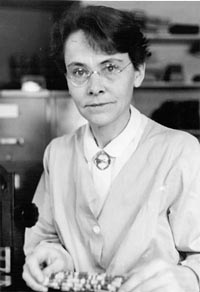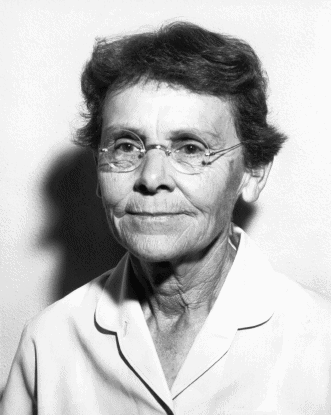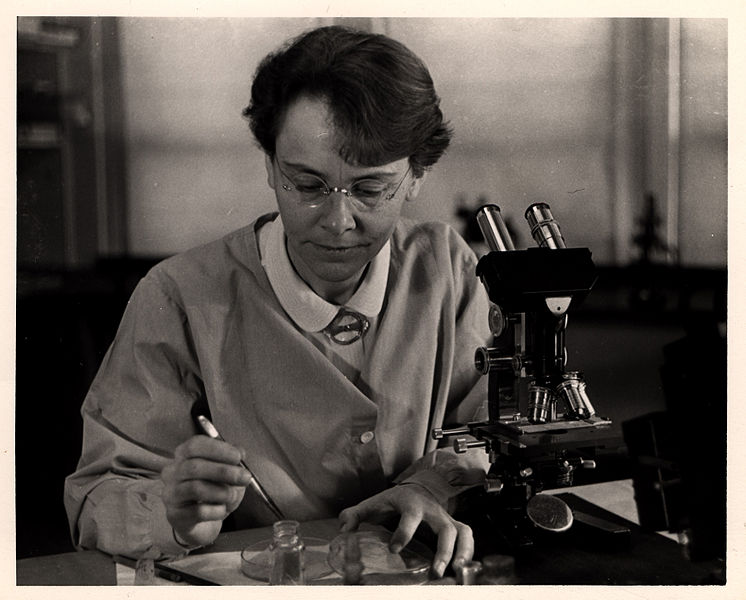<Back to Index>
- Cytogeneticist Barbara McClintock, 1902
- Actor and Director Arthur Stanley Jefferson (Stan Laurel), 1890
- Apache Leader and Warrior Geronimo, 1829



Barbara McClintock (June 16, 1902 – September 2, 1992), the 1983 Nobel Laureate in Physiology or Medicine, was an American scientist and one of the world's most distinguished cytogeneticists. McClintock received her PhD in botany from Cornell University in 1927, where she was a leader in the development of maize cytogenetics. The field remained the focus of her research for the rest of her career. From the late 1920s, McClintock studied chromosomes and how they change during reproduction in maize. Her work was groundbreaking: she developed the technique for visualizing maize chromosomes and used microscopic analysis to demonstrate many fundamental genetic ideas, including genetic recombination by crossing-overduring meiosis — a mechanism by which chromosomes exchange information. She produced the first genetic map for maize, linking regions of the chromosome with physical traits, and demonstrated the role of the telomere and centromere, regions of the chromosome that are important in the conservation of genetic information. She was recognized amongst the best in the field, awarded prestigious fellowships, and elected a member of the National Academy of Sciences in 1944.
During the 1940s and 1950s, McClintock discovered transposition and used it to show how genes are
responsible for turning physical characteristics on or off. She
developed theories to explain the repression or expression of genetic
information from one generation of maize plants to the next.
Encountering skepticism of her research and its implications, she
stopped publishing her data in 1953. Later, she made an extensive study
of the cytogenetics and ethnobotany of maize races from
South America. McClintock's research became well understood in the
1960s and 1970s, as researchers demonstrated the mechanisms of genetic
change and genetic regulation that
she had demonstrated in her maize research in the 1940s and 1950s.
Awards and recognition for her contributions to the field followed,
including the Nobel Prize for Physiology or Medicine, awarded to her in
1983 for the discovery of genetic transposition; she is the only woman to receive an unshared Nobel Prize in that category. Barbara McClintock was born in Hartford, Connecticut,
the third of four children of physician Thomas Henry McClintock and
Sara Handy McClintock. She was independent from a very young age, a
trait McClintock described as her "capacity to be alone". From about
the age of three until the time she started school, McClintock lived
with an aunt and uncle in Brooklyn, New York, in order to reduce the
financial burden on her parents while her father established his
medical practice. She was described as a solitary and independent
child, and a tomboy. She was close to her father, but had a difficult
relationship with her mother. McClintock completed her secondary education at Erasmus Hall High School in Brooklyn. She discovered science at high school, and wanted to attend Cornell University to
continue her studies. Her mother resisted the idea of higher education
for her daughters, believing it would make them unmarriageable. The
family also had financial problems. Barbara was almost prevented from
starting college, but her father intervened, and she entered Cornell in
1919. McClintock began her studies at Cornell's College of Agriculture in 1919. She studied botany, receiving a BSc in
1923. Her interest in genetics had been sparked when she took her first
course in that field in 1921. The course was based on a similar one
offered at Harvard University, and was taught by C.B. Hutchison, a plant breeder and geneticist. Hutchinson
was impressed by McClintock's interest, and telephoned to invite her to
participate in the graduate genetics course at Cornell in 1922.
McClintock pointed to Hutchinson's invitation as the reason she
continued in genetics: "Obviously, this telephone call cast the die for
my future. I remained with genetics thereafter." Although
it has been reported that women could not major in genetics at Cornell,
and therefore her MA and PhD — earned in 1925 and 1927,
respectively — were officially awarded in botany, recent research has
revealed that women did earn graduate degrees in Cornell's Plant
Breeding Department during the time that McClintock was a student at
Cornell. During
her graduate studies and postgraduate appointment as a botany
instructor, McClintock was instrumental in assembling a group that
studied the new field of cytogenetics in maize. This group brought together plant breeders and cytologists, and included Charles R. Burnham, Marcus Rhoades, George Beadle (who became a Nobel laureate in 1958 for showing that genes control metabolism), and Harriet Creighton. Rollins Adams Emerson, head of the Plant Breeding Department, supported these efforts, although he was not a cytologist himself. McClintock's
cytogenetic research focused on developing ways to visualize and
characterize maize chromosomes. This particular part of her work
influenced a generation of students, as it was included in most
textbooks. She also developed a technique using carmine staining to visualize maize chromosomes, and showed for the first time the morphology of the 10 maize chromosomes. By studying the morphology of the chromosomes, McClintock was able to link, to a specific chromosome, groups of traits that were inherited together. Marcus Rhoades noted that McClintock's 1929 Genetics paper on the characterization of triploid maize
chromosomes triggered scientific interest in maize cytogenetics, and
attributed to his female colleague 10 of the 17 significant advances in
the field that were made by Cornell scientists between 1929 and 1935. In
1930, McClintock was the first person to describe the cross-shaped
interaction of homologous chromosomes during meiosis. During 1931,
McClintock and a graduate student, Harriet Creighton, proved the link between chromosomal crossoverduring meiosis and the recombination of genetic traits. They observed how the recombination of chromosomes and the resulting phenotype formed the inheritance of a new trait. Until this point, it had only been hypothesized that genetic recombination could
occur during meiosis, although it had been shown genetically.
McClintock published the first genetic map for maize in 1931, showing
the order of three genes on maize chromosome 9. This information provided necessary data for the crossing over study she published with Creighton. In 1938, she produced a cytogenetic analysis of the centromere, describing the organization and function of the centromere. McClintock's
breakthrough publications, and support from her colleagues, led to her
being awarded several postdoctoral fellowships from the National Research Council. This funding allowed her to continue to study genetics at Cornell, the University of Missouri, and the California Institute of Technology, where she worked with E.G. Anderson. During the summers of 1931 and 1932, she worked at Missouri with geneticist Lewis Stadler, who introduced her to the use of X-rays as a mutagen.
(Exposure to X-rays can increase the rate of mutation above the natural
background level, making it a powerful research tool for genetics.)
Through her work with X-ray mutagenized maize, she identified ring chromosomes,
which form when the ends of a single chromosome fuse together after
radiation damage. From this evidence, McClintock hypothesized that
there must be a structure on the chromosome tip that would normally
ensure stability. She showed that the loss of ring-chromosomes at
meiosis caused variegation in
maize foliage in generations subsequent to irradiation resulting from
chromosomal deletion. During this period, she demonstrated the presence
of what she called the nucleolar organizers on a region on maize chromosome 6, which is required for the assembly of the nucleolus. McClintock received a fellowship from the Guggenheim Foundation that made possible six months of training in Germany during 1933 and 1934. She had planned to work with Curt Stern, who had demonstrated crossing-over in Drosophila just
weeks after McClintock and Creighton had done so; however, in the
meantime, Stern emigrated to the United States. Instead, she worked in
Germany with geneticist Richard B. Goldschmidt.
She left Germany early, amid mounting political tension in Europe, and
returned to Cornell, remaining there until 1936, when she accepted an
Assistant Professorship offered to her by Lewis Stadler in the
Department of Botany at the University of Missouri–Columbia. During
her time at Missouri, McClintock expanded her research on the effect of
X-rays on maize cytogenetics. McClintock observed the breakage and
fusion of chromosomes in irradiated maize cells. She was also able to
show that, in some plants, spontaneous chromosome breakage occurred in
the cells of the endosperm. Over the course of mitosis, she observed that the ends of broken chromatids were rejoined after the chromosome replication. In the anaphase of
mitosis, the broken chromosomes formed a chromatid bridge, which was
broken when the chromatids moved towards the cell poles. The broken
ends were rejoined in the interphase of
the next mitosis, and the cycle was repeated, causing massive mutation,
which she could detect as variegation in the endosperm. This
cycle of breakage, fusion, and bridge, also described as the
breakage–rejoining–bridge cycle, was a key cytogenetic discovery for
several reasons. First it showed that the rejoining of chromosomes was
not a random event, and secondly it demonstrated a source of
large-scale mutation. For this reason, it remains an area of interest in cancer research today. Although
her research was progressing at Missouri, McClintock was not satisfied
with her position at the University. She recalled being excluded from
faculty meetings, and was not made aware of positions available at
other institutions. In
1940 she wrote to Charles Burnham, "I have decided that I must look for
another job. As far as I can make out, there is nothing more for me
here. I am an assistant professor at $3,000 and I feel sure that that
is the limit for me." Initially, McClintock's position had been especially created for her by Stadler and may have depended on his presence. McClintock believed she would not gain tenure at Missouri, although according to some accounts she knew she would be offered a promotion by Missouri in the spring of 1942. Recent evidence reveals that McClintock more likely decided to leave Missouri
because she had lost trust in her employer and in the University
administration. In
early 1941 she was invited by the Director of the Department of
Genetics at Cold Spring Harbor to spend her summer there. She took a
leave of absence from Missouri in hopes of finding a position
elsewhere. She also accepted a visiting Professorship at Columbia University,
where her former Cornell colleague Marcus Rhoades was a professor. He
offered to share his research field at Cold Spring Harbor on Long
Island. In December 1941 she was offered a research position by Milislav Demerec, the newly appointed acting director, and she joined the staff of the Carnegie Institution of Washington's Department of Genetics Cold Spring Harbor Laboratory.
After
her year-long temporary appointment, McClintock accepted a full-time
research position at Cold Spring Harbor Laboratory. Here, she was
highly productive and continued her work with the
breakage-fusion-bridge cycle, using it to substitute for X-rays as a
tool for mapping new genes. In 1944, in recognition of her prominence
in the field of genetics during this period, McClintock was elected to
the National Academy of Sciences — only the third woman to be elected. In 1945, she became the first woman president of the Genetics Society of America. In 1944 she undertook a cytogenetic analysis of Neurospora crassa at
the suggestion of George Beadle, who had used the fungus to demonstrate
the one gene–one enzyme relationship. He invited her to Stanford to undertake the study. She successfully described the number of chromosomes, or karyotype, of N. crassa and described the entire life cycle of the species. N. crassa has since become a model species for classical genetic analysis. In the summer of 1944 at Cold Spring Harbor Laboratory, McClintock began systematic studies on the mechanisms of the mosaic color patterns of maize seed and the unstable inheritance of this mosaicism. She identified two new dominant and interacting genetic loci that she named Dissociator (Ds) and Activator (Ac). She found that the Dissociator did not just dissociate or cause the chromosome to break, it also had a variety of effects on neighboring genes when the Activator was also present. In early 1948, she made the surprising discovery that both Dissociator and Activator could transpose, or change position, on the chromosome. She observed the effects of the transposition of Ac and Ds by
the changing patterns of coloration in maize kernels over generations
of controlled crosses, and described the relationship between the two loci through intricate microscopic analysis. She concluded that Ac controls the transposition of the Ds from chromosome 9, and that the movement of Ds is accompanied by the breakage of the chromosome. When Ds moves, the aleurone-color gene is released from the suppressing effect of the Ds and transformed into the active form, which initiates the pigment synthesis in cells. The transposition of Ds in
different cells is random, it may move in some but not others, which
causes color mosaicism. The size of the colored spot on the seed is
determined by stage of the seed development during dissociation.
McClintock also found that the transposition of Ds and the is determined by the number of Ac copies in the cell. Between
1948 and 1950, she developed a theory by which these mobile elements
regulated the genes by inhibiting or modulating their action. She
referred to Dissociator and Activator as "controlling units" — later, as "controlling elements" — to distinguish them from genes. She hypothesized that gene regulation could explain how complex multicellular organisms made of cells with identical genomes have
cells of different function. McClintock's discovery challenged the
concept of the genome as a static set of instructions passed between
generations. In 1950, she reported her work on Ac/Ds and
her ideas about gene regulation in a paper entitled "The origin and
behavior of mutable loci in maize" published in the journal Proceedings of the National Academy of Sciences.
In summer 1951, when she reported on her work on gene mutability in
maize at the annual symposium at Cold Spring Harbor Laboratory, the
paper she presented was called "Chromosome organization and genic
expression".
Her
work on controlling elements and gene regulation was conceptually
difficult and was not immediately understood or accepted by her
contemporaries; she described the reception of her research as
"puzzlement, even hostility". Nevertheless, McClintock continued to develop her ideas on controlling elements. She published a paper in Genetics in
1953 where she presented all her statistical data, and undertook
lecture tours to universities throughout the 1950s to speak about her
work. She continued to investigate the problem and identified a new element that she called Suppressor-mutator (Spm), which, although similar to Ac/Ds,
displays more complex behavior. Based on the reactions of other
scientists to her work, McClintock felt she risked alienating the
scientific mainstream, and from 1953 stopped publishing accounts of her
research on controlling elements. McClintock
officially retired from her position at the Carnegie Institution in
1967, and was made a Distinguished Service Member of the Carnegie
Institution of Washington. This honor allowed her to continue working
with graduate students and colleagues in the Cold Spring Harbor
Laboratory as scientist emerita.
In reference to her decision 20 years earlier no longer to publish
detailed accounts of her work on controlling elements, she wrote in
1973: Over
the years I have found that it is difficult if not impossible to bring
to consciousness of another person the nature of his tacit assumptions
when, by some special experiences, I have been made aware of them. This
became painfully evident to me in my attempts during the 1950s to
convince geneticists that the action of genes had to be and was
controlled. It is now equally painful to recognize the fixity of
assumptions that many persons hold on the nature of controlling
elements in maize and the manners of their operation. One must await
the right time for conceptual change. The importance of McClintock's contributions only came to light in the 1960s, when the work of French geneticists Francois Jacob and Jacques Monod described the genetic regulation of the lac operon, a concept she had demonstrated with Ac/Ds in 1951. Following Jacob and Monod's 1961 Journal of Molecular Biology paper "Genetic regulatory mechanisms in the synthesis of proteins", McClintock wrote an article for American Naturalist comparing the lac operon and her work on controlling elements in maize. McClintock's contribution to biology is still not widely acknowledged as amounting to the discovery of genetic regulation. McClintock
was widely credited for discovering transposition following the
discovery of the process in bacteria and yeast in the late 1960s and
early 1970s. During this period, molecular biology had developed
significant new technology, and scientists were able to show the
molecular basis for transposition. In the 1970s, Ac and Ds were cloned by other scientists and were shown to be Class II transposons. Ac is a complete transposon that can produce a functional transposase, which is required for the element to move within the genome. Ds has
a mutation in its transposase gene, which means that it cannot move
without another source of transposase. Thus, as McClintock observed, Ds cannot move in the absence of Ac. Spm has
also been characterized as a transposon. Subsequent research has shown
that transposons typically do not move unless the cell is placed under
stress, such as by irradiation or the breakage, fusion, and bridge
cycle, and thus their activation during stress can serve as a source of
genetic variation for evolution. McClintock understood the role of
transposons in evolution and genome change well before other
researchers grasped the concept. Nowadays, Ac/Ds is used as a tool in plant biology to generate mutant plants used for the characterization of gene function. McClintock was awarded the National Medal of Science by Richard Nixon in 1971. Cold Spring Harbor named a building in her honor in 1973. In 1981 she became the first recipient of the MacArthur Foundation Grant, and was awarded the Albert Lasker Award for Basic Medical Research, the Wolf Prize in Medicine and the Thomas Hunt Morgan Medal by the Genetics Society of America. In 1982 she was awarded the Louisa Gross Horwitz Prize from Columbia University for her research in the "evolution of genetic information and the control of its expression." Most notably, she received the Nobel Prize for Physiology or Medicine in 1983, credited by the Nobel Foundation for
discovering "mobile genetic elements", over thirty years after she
initially described the phenomenon of controlling elements. She
was awarded 14 Honorary Doctor of Science degrees and an Honorary
Doctor of Humane Letters. In 1986 she was inducted into the National Women's Hall of Fame. During her final years, McClintock led a more public life, especially after Evelyn Fox Keller's 1983 book A feeling for the organism brought
McClintock's story to the public. She remained a regular presence in
the Cold Spring Harbor community, and gave talks on mobile genetic
elements and the history of genetics research for the benefit of junior
scientists. An anthology of her 43 publications The discovery and characterization of transposable elements: the collected papers of Barbara McClintock was published in 1987. McClintock died in Huntington, New York, on September 2, 1992 at the age of 90; she never married or had children.
In 1957, McClintock received funding from the National Science Foundation, and the Rockefeller Foundation sponsored her to start research on maize in South America, an area that is rich in varieties of this species. She was interested in studying the evolution of
maize, and being in South America would allow her to work on a larger
scale. McClintock explored the chromosomal, morphological, and
evolutionary characteristics of various races of
maize. From 1962, she supervised four scientists working on South
American maize at the North Carolina State University in Raleigh. Two
of these Rockefeller fellows, Almiro Blumenschein and T. Angel Kato,
continued their research on South American races of maize well into the
1970s. In 1981, Blumenschein, Kato, and McClintock published Chromosome constitution of races of maize, which is considered a landmark study of maize that has contributed significantly to the fields of evolutionary botany, ethnobotany, and paleobotany.
